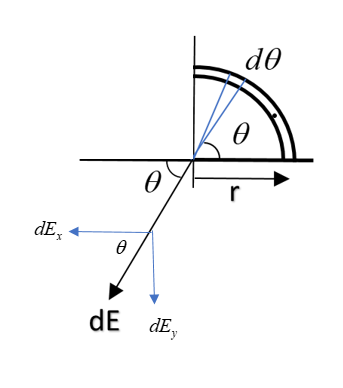
Electric field at the centre of a quarter circular ring having charge density $\lambda$ is:


Answer
572.7k+ views
Hint: Here, it is important to note that the charge is distributed over an object. Hence we can’t directly apply Coulomb's law which is valid for point charge. Hence we need to get the electric field due to any general element and then integrate over the ring to get a net electric field at the centre.
Formula used:
$dE = \dfrac{Kdq}{r^2}$
Complete answer:
First of all, we have to consider an elementary part of the ring at an angle $\theta$ having angular length of $d\theta$. The small charge inside the elementary part will be calculated as follows:
Charge density $\lambda$ is defined as charge per unit length. Thus, the charge in the elementary part ‘$Rd\theta$’ will be $\lambda Rd\theta$.
Thus $dq = \lambda Rd\theta$
Now, using $dE = \dfrac{Kdq}{r^2}$, we have
$dE = \dfrac{K\lambda R d\theta}{R^2} = \dfrac{K\lambda d\theta}{R}$
Now, as the ring is unsymmetric, we have to find the field in both directions i.e. in x direction and in y direction separately.

So, field in x-direction: $dE_x = dE cos \theta$
$dE_x = \dfrac{K\lambda cos\theta d\theta}{R}$
Integrating, we get:
$\int dE_x = \int \limits_{0}^{\pi /2} \dfrac{K\lambda}{R}cos\theta d\theta$
$E_x = \dfrac{K\lambda}{R}\int \limits_{0}^{\pi /2} cos\theta d\theta = \dfrac{K\lambda}{R}\left( sin(\dfrac{\pi}{2}) - sin 0 \right) = \dfrac{K\lambda}{R}$
Also, field in y-direction:
$dE_{y} = dE sin\theta = \dfrac{K\lambda}{R}\times sin\theta d\theta$
Then, $E_{y} = \int dE sin\theta= \int \dfrac{K\lambda}{ R} \times sin\theta d\theta$
Or, ${{E}_{y}}=\frac{K\lambda}{ {{R}{}}}\times \int\limits_{0}^{\pi/2 }{sin\theta {d}}\theta$ [ as K. q and r are constants ]
${{E}_{y}}=\frac{K\lambda}{ {{R}{}}}\times -\left(cos(\pi/2) - cos 0\right) = \dfrac{K\lambda}{R}$
Now, the net field will be the vector sum of both x and y component:
Thus, $E_{net} = \sqrt{E_x^2+E_y^2}$
Or $E_{net} = \sqrt{\left(\dfrac{K\lambda}R\right)^2+\left(\dfrac{K\lambda}R\right)^2}$
$\implies E_{net} = \sqrt2 \dfrac{K\lambda}{R}$
Note:
This type of question must be tackled only by taking a small element and writing electric fields for smaller elements. In some questions, the figure might be symmetric. In that case, we can directly write the component of the electric field which is symmetric as zero. Also students should understand how to take the limits. If the material were present in the first as well as second quadrant, we might have taken the limits from 0 to $\pi$ instead of 0 to$\dfrac{\pi}{2}$.
Formula used:
$dE = \dfrac{Kdq}{r^2}$
Complete answer:
First of all, we have to consider an elementary part of the ring at an angle $\theta$ having angular length of $d\theta$. The small charge inside the elementary part will be calculated as follows:
Charge density $\lambda$ is defined as charge per unit length. Thus, the charge in the elementary part ‘$Rd\theta$’ will be $\lambda Rd\theta$.
Thus $dq = \lambda Rd\theta$
Now, using $dE = \dfrac{Kdq}{r^2}$, we have
$dE = \dfrac{K\lambda R d\theta}{R^2} = \dfrac{K\lambda d\theta}{R}$
Now, as the ring is unsymmetric, we have to find the field in both directions i.e. in x direction and in y direction separately.

So, field in x-direction: $dE_x = dE cos \theta$
$dE_x = \dfrac{K\lambda cos\theta d\theta}{R}$
Integrating, we get:
$\int dE_x = \int \limits_{0}^{\pi /2} \dfrac{K\lambda}{R}cos\theta d\theta$
$E_x = \dfrac{K\lambda}{R}\int \limits_{0}^{\pi /2} cos\theta d\theta = \dfrac{K\lambda}{R}\left( sin(\dfrac{\pi}{2}) - sin 0 \right) = \dfrac{K\lambda}{R}$
Also, field in y-direction:
$dE_{y} = dE sin\theta = \dfrac{K\lambda}{R}\times sin\theta d\theta$
Then, $E_{y} = \int dE sin\theta= \int \dfrac{K\lambda}{ R} \times sin\theta d\theta$
Or, ${{E}_{y}}=\frac{K\lambda}{ {{R}{}}}\times \int\limits_{0}^{\pi/2 }{sin\theta {d}}\theta$ [ as K. q and r are constants ]
${{E}_{y}}=\frac{K\lambda}{ {{R}{}}}\times -\left(cos(\pi/2) - cos 0\right) = \dfrac{K\lambda}{R}$
Now, the net field will be the vector sum of both x and y component:
Thus, $E_{net} = \sqrt{E_x^2+E_y^2}$
Or $E_{net} = \sqrt{\left(\dfrac{K\lambda}R\right)^2+\left(\dfrac{K\lambda}R\right)^2}$
$\implies E_{net} = \sqrt2 \dfrac{K\lambda}{R}$
Note:
This type of question must be tackled only by taking a small element and writing electric fields for smaller elements. In some questions, the figure might be symmetric. In that case, we can directly write the component of the electric field which is symmetric as zero. Also students should understand how to take the limits. If the material were present in the first as well as second quadrant, we might have taken the limits from 0 to $\pi$ instead of 0 to$\dfrac{\pi}{2}$.
Recently Updated Pages
A man running at a speed 5 ms is viewed in the side class 12 physics CBSE

State and explain Hardy Weinbergs Principle class 12 biology CBSE

Which of the following statements is wrong a Amnion class 12 biology CBSE

Two Planoconcave lenses 1 and 2 of glass of refractive class 12 physics CBSE

The compound 2 methyl 2 butene on reaction with NaIO4 class 12 chemistry CBSE

Bacterial cell wall is made up of A Cellulose B Hemicellulose class 12 biology CBSE

Trending doubts
What are the major means of transport Explain each class 12 social science CBSE

Which are the Top 10 Largest Countries of the World?

Draw a labelled sketch of the human eye class 12 physics CBSE

Explain sex determination in humans with line diag class 12 biology CBSE

The pH of the pancreatic juice is A 64 B 86 C 120 D class 12 biology CBSE

Give 10 examples of unisexual and bisexual flowers




